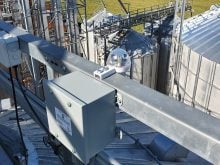San Francisco, California (Reuters) – A global water crisis is looming, but the path to profits is a muddy mess of regulated industries, giant companies with small water operations, and start-up technologies.
For Alex Miles, who once ran a water hedge fund and now manages $350 million at Kingfisher Capital, successful investing in water means going beyond it. Commodities, power and efficiency technology are all ways to make a portfolio splash.
Water scarcity has become a global issue as climate change alters water availability, population growth raises demand, and contamination threatens clean supplies.
Read Also

Chinese offer complicates canola marketing
Recently the Chinese ambassador indicated that there would be a potential deal between Canada and China regarding the current tariff war.
But what seems to be an obvious investment opportunity has challenges, including the belief that water is a public good, not a profit source.
“If water were not viewed as a human right, it would be a great investment,” said Miles, who believes water shortages, like gravity, are inescapable.
Miles ran Aqueduct, one of the first hedge funds in water from 2006 to 2009. His Kingfisher’s Value Opportunity flagship fund, which has water as one focus, has outperformed the Standard & Poor’s 500 index by 3.65 percentage points annually between its inception at the end of 2004 and the end of June 2009, he said.
In an interview at a recent Green Power conference in San Francisco, he explained how to invest in ways that could help alleviate crisis as well as profit from its effects, such as higher grain prices.
“The fault of the investment community is that they have looked at water too narrowly,” he said.
Water investment can be made in primary industries, like utilities that produce, treat and transport water. But it should also include related industries, such as smart grid and pollution management that could increase efficiency of water use, and products tied to water, like food.
Heavy regulation limits returns at publicly traded water utilities, while the biggest players in water technology, such as General Electric and Siemens AG, are even bigger in other areas, diluting their value for someone wanting a targeted water investment.
One pure play would be small-cap Energy Recovery Inc, which makes equipment that cuts energy use at desalination plants and other enterprises that clean water.
Secondary industries that are closely related to water offer other opportunities. Moving and heating water is a major energy draw, while water is crucial to producing energy, from mining to natural gas extraction to cooling power plants.
Bets on water include meter companies focused on water and building an electricity smart grid, Miles said. He cited companies such as Badger Meter, Itron Inc. and EnerNOC, a demand response company that sells contracts to cut electricity demand when needed by power companies.
Miles declined to recommend any specific investment, but argued that many of the water companies had been chewed up by credit fears that had nothing to do with the underlying demand for their wares and services.
“Investors in water have to take a long-term view,” he said. “A lot of these stocks have struggled because of the global credit crisis rather than because of their business models.”
Water use is often energy-intensive, and thus carbon-intensive, because many industries endanger water. So increased focus on carbon and water go hand in hand, he said.
“Carbon prices should go up, reflective of (the) water crisis,” he said.
Investing in the Climate Exchange Plc, a publicly traded company that runs exchanges for greenhouse gases, could be seen as water investment, he said.
Miles expects the crisis to intensify, despite technology improvements. The best strategy for “water crisis” investors is grain and other soft commodities, he said.
Water prices will rise because needs will be so dire and governments such as the United States will have more pressing priorities. But regulation and fragmented markets mean the water price rise will lag price increases in products that use water, like food.
“I want to be long agricultural commodities,” he said.














